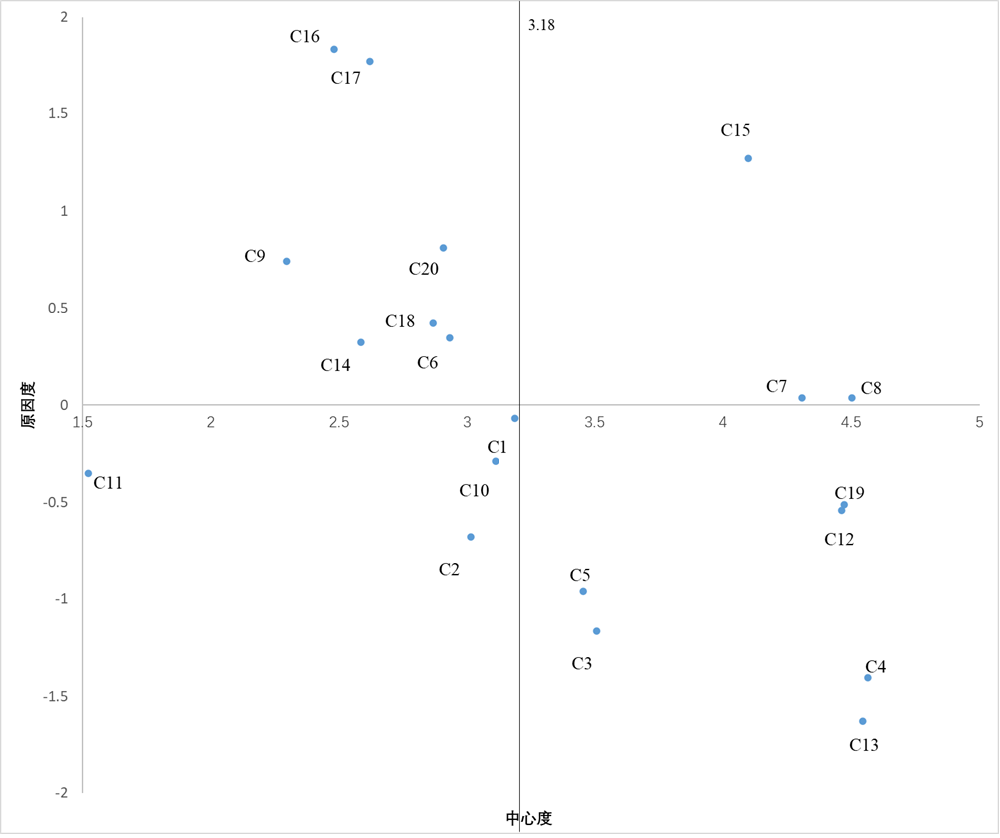 PDF(1462 KB)
PDF(1462 KB)


 PDF(1462 KB)
PDF(1462 KB)
 PDF(1462 KB)
PDF(1462 KB)
数智环境下老年人健康信息服务可及性影响因素研究
Study on the Factors Influencing the Accessibility of Health Information Services for the Elderly in a Digital Intelligence Environment
[目的/意义]探索数智环境下老年人健康信息服务的可及性能够为老年友好型社会建设提供有效的保障,探寻其影响因素及影响关系具有重要意义。[方法/过程]基于信息生态理论,从信息、信息人、信息环境、信息技术4个维度提取影响因素,运用决策实验室分析法(DEMATEL)识别出关键影响因素,并通过解释结构模型(ISM)方法确定关键影响因素的层级结构与关联路径。[结果/结论]结果表明,数据存储技术、信息协调与共享、政策法规、通信基础设施4个根源因素,需求契合性和服务稳定性2个表层因素对可及性提升有着重要影响,由此提出优化健康信息资源配置、引导适老化服务建设、完善基础设施建设的建议。
[Purpose/Significance] Exploring the accessibility of health information services for the elderly in the digital intelligence environment can provide an effective guarantee for the construction of healthy aging, and it is of great significance to explore its influencing factors and influence relationships. [Method/Process] Based on the information ecology theory, the influencing factors were extracted from 4 dimensions of information, information people, information environment and information technology, and the key influencing factors were identified by using DEMATEL method, and the hierarchical structure and association path of key influencing factors were determined by using ISM method. [Result/Conclusion] The results showed that 4 root factors of data storage technology, information coordination and sharing, policies and regulations, and communication infrastructure, as well as 2 surface factors of demand fit and service stability, have an important impact on accessibility enhancement, and thus suggested optimizing health information resource allocation, guiding age-appropriate service construction, and improving infrastructure construction.

数智环境 / 老年人健康信息服务 / 可及性 / 影响因素研究 / DEMATEL-ISM
digital intelligence environment / health information service for the elderly / accessibility / influence factor research / DEMATEL-ISM
| [1] |
孙建军,李阳,裴雷.“数智”赋能时代图情档变革之思考[J].图书情报知识,2020(3):22-27.
|
| [2] |
徐孝婷,杨梦晴,朱庆华.面向老年群体的智慧社区联动协作健康信息服务模式构建[J].图书馆论坛,2020,40(12): 107-116.
|
| [3] |
翟兴,肖源,王若佳,等. 数智环境下智慧健康信息服务体系构建研究[J].情报科学:2022,40(10):43-50.
|
| [4] |
钱宇星,周华阳,周利琴,等.老年在线社区用户健康信息需求挖掘研究[J]. 现代情报, 2019, 39(6): 59-69.
|
| [5] |
吴江,李姗姗.在线健康社区用户信息服务使用意愿研究[J].情报科学,2017,35(4):119-125.
|
| [6] |
高冰洁,张宁.老年人在线健康信息行为的研究现状与前沿展望[J].图书馆学研究,2020(6):9-16,77.
|
| [7] |
唐晖岚,文庭孝,罗爱静,等.网络健康信息精准服务模式研究[J]. 现代情报, 2019, 39(7): 109-114,127.
|
| [8] |
ADAY L A, ANDERSEN R. A framework for the study of access to medical care[J]. Health services research, 1974, 9(3): 208-220.
|
| [9] |
PENCHANSKY R, THOMAS J W. The concept of access: definition and relationship to consumer satisfaction[J]. Medical care, 1981,19(2): 127-140.
|
| [10] |
王前,吴理财.公共文化服务可及性评价研究:经验借鉴与框架建构[J]. 上海行政学院学报, 2015, 16(3): 53-59.
|
| [11] |
严则金, 潘雨婷, 庞春梅. 公共图书馆健康信息服务供给影响因素:解释结构模型的应用[J/OL]. 图书馆论坛: 1-11. [2023-02-24].http://kns.cnki.net/kcms/detail/44.1306.G2.20221222.1009.005.html.
|
| [12] |
赵栋祥,马费成,张奇萍.老年人健康信息搜寻行为的现象学研究[J].情报学报,2019,38(12): 1320-1328.
|
| [13] |
孙欣然,孙金海,陈立富,等.老年人健康需求特点与健康管理对策[J].中国老年学杂志, 2018, 38(21): 5364-5367.
|
| [14] |
刘一鸣,杨进娴.区块链技术支撑老年人健康信息精准服务可行性研究[J].数字图书馆论坛,2022(10):56-64.
|
| [15] |
刘奕,李晓娜.数字时代我国社区智慧养老模式比较与优化路径研究[J].电子政务,2022(5):112-124.
|
| [16] |
罗娟.过程型逻辑:数字乡村建设背景下农村公共文化服务可及性的实现机制[J].农村经济,2022(10):82-90.
|
| [17] |
刘一鸣,李露.图书馆老年人健康信息服务研究综述[J].图书情报工作, 2021,65(24):123-134.
|
| [18] |
马海云,曹思源,薛翔.面向用户需求的健康领域知识组织与服务框架研究[J].情报资料工作,2022,43(2):84-92.
|
| [19] |
李蛟.新媒体环境下公共图书馆健康信息服务的三螺旋模型与关键影响因素研究[J].情报科学,2022,40(9):64-71.
|
| [20] |
刘冰,张文珏.基于用户视角的网络健康信息服务质量评价体系构建研究[J].情报科学,2019,37(12):40-46
|
| [21] |
张敏,罗梅芬,张艳.国内外移动医疗用户采纳行为的系统综述——知识基础、影响因素与前沿展望[J]. 现代情报,2018, 38(8):154-162.
|
| [22] |
代沁泉,熊回香,沈舒悦,等.面向“健康中国2030”的数字移民健康管护服务模型构建[J/OL].图书馆论坛:1-11[2023-02-24].http://kns.cnki.net/kcms/detail/44.1306.G2.20230112.1516.008.html.
|
| [23] |
李华锋,孙晓宁,袁勤俭.老年人在线信息搜寻行为研究述评[J].图书情报知识,2021(2):79-87.
|
| [24] |
张敏,刘雪瑞,张艳.在线健康社区用户诊疗信息求助行为形成机理的概念模型——基于扎根理论的探索性研究[J].情报科学,2019,37(4):22-28.
|
| [25] |
刘嫣,张海涛,李佳玮,等.移动终端视角下的老年用户在线健康信息搜寻行为影响因素研究[J].图书情报工作,2021,65(11):46-54.
|
| [26] |
邓朝华,洪紫映.在线医疗健康服务医患信任影响因素实证研究[J].管理科学,2017,30(1):43-52.
|
| [27] |
杜鹏,韩文婷.互联网与老年生活:挑战与机遇[J].人口研究,2021,45(3):3-16.
|
| [28] |
BEAUNOYER E, DUPÉRÉ S, GUITTON M J. COVID-19 and digital inequalities: reciprocal impacts and mitigation strategies[J]. Computers in human behavior, 2020, 111: 106424.
|
| [29] |
黄欢欢,曹松梅,肖明朝,等.社区居家老年人老年科技接受及影响因素的描述性质性研究[J]. 解放军护理杂志, 2021,38(10):4-7.
|
| [30] |
马费成,周利琴.面向智慧健康的知识管理与服务[J].中国图书馆学报,2018,44(5):4-19.
|
| [31] |
赵奕钧,邓大松.人工智能驱动下智慧养老服务模式构建研究[J].江淮论坛,2021(2):146-152.
|
| [32] |
王晓慧,向运华.老年智慧照护服务体系探究[J].学习与实践,2019(5):88-97.
|
| [33] |
姜明男,薛星群,杨毅.基于SVM的在线医疗信息服务质量关键影响因素研究[J].情报科学,2020,38(3):70-77.
|
| [34] |
谢刚, 李国平. 广义梯度理论中梯度的解释结构模型研究[J].系统工程,2004(5):1-6.
|
| [35] |
袁红,王焘.政府数据开放可持续发展关键影响因素识别与作用机理分析[J].图书情报工作,2022,66(9):53-65.
|
/
| 〈 |
|
〉 |